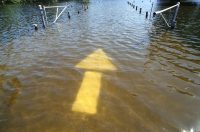Archives
Site practices and BMP solutions for stormwater management
Avoid the pitfalls. According to Willobee, there are common design concerns that SWPPPs frequently overlook. He sees the following problems in many construction SWPPPs: Failure to specify appropriate stabilization measures for temporary diversion ditches Excessive reliance on sediment control practices such as silt fences, sediment basins, and inlet protection Lack of run-on controls Insufficient information […]
OSHA Proposes New Limits for Silica Exposure
As you probably know, OSHA is proposing to change the exposure limit for silica. Learn the details in today’s Advisor. OSHA is inviting and strongly encouraging the public to participate in the process of developing a final rule for silica exposure through written comments and participation in public hearings. You have until December 11 to […]
Could Flooding Affect Your Business? Now’s the Time to Find Out
Learn About Latex
Latex allergies are mostly annoying but sometimes more serious, so train employees who are exposed to latex on how they can protect themselves from having allergic reactions to latex. The latex allergy is actually a reaction to certain proteins in latex rubber. While it’s not known just how much latex exposure will create sensitization or […]
Ammonium Nitrate—Handle (Store and Manage) with Care
Ammonium Nitrate—Explosive Lessons Learned
How One Company Protects Its Lone Workers
At Georgia Power, protecting lone workers is serious business, according to its safety and health general manager. Hamilton Hardin, safety and health general manager, says that Georgia Power makes every effort to ensure that lone workers, like all employees, are treated like "prized assets." Among other things, that means they get comprehensive safety training and […]
Working Alone Shouldn’t Mean Working at Risk
Millions of employees work away from their employer’s location. If some of them are yours, although you don’t see them every day, you’re still responsible for their safety and health. Lone workers perform their jobs on the road, at client’s sites, in home offices, and other locations distant from your workplace. Some, like security guards […]
Part 109 Rules for Oil Spill Response Resources
In addition to the personnel requirements we reviewed yesterday, Part 109 also defines how facilities that do not have a Facility Response Plan (FRP) in place and that have made the determination that required secondary containment is impracticable, should both have and be prepared to obtain necessary spill response equipment. In general, according to the […]




